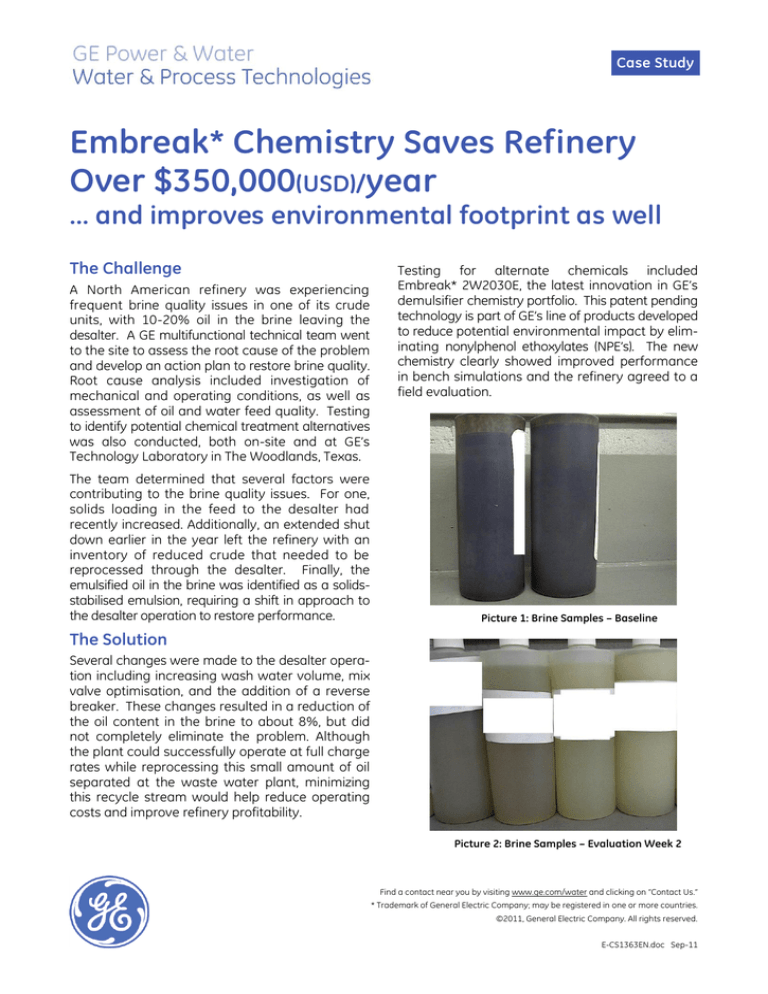
Case Study
Embreak* Chemistry Saves Refinery
Over $350,000(USD)/year
… and improves environmental footprint as well
The Challenge
A North American refinery was experiencing
frequent brine quality issues in one of its crude
units, with 10-20% oil in the brine leaving the
desalter. A GE multifunctional technical team went
to the site to assess the root cause of the problem
and develop an action plan to restore brine quality.
Root cause analysis included investigation of
mechanical and operating conditions, as well as
assessment of oil and water feed quality. Testing
to identify potential chemical treatment alternatives
was also conducted, both on-site and at GE’s
Technology Laboratory in The Woodlands, Texas.
The team determined that several factors were
contributing to the brine quality issues. For one,
solids loading in the feed to the desalter had
recently increased. Additionally, an extended shut
down earlier in the year left the refinery with an
inventory of reduced crude that needed to be
reprocessed through the desalter. Finally, the
emulsified oil in the brine was identified as a solidsstabilised emulsion, requiring a shift in approach to
the desalter operation to restore performance.
Testing for alternate chemicals included
Embreak* 2W2030E, the latest innovation in GE’s
demulsifier chemistry portfolio. This patent pending
technology is part of GE’s line of products developed
to reduce potential environmental impact by eliminating nonylphenol ethoxylates (NPE’s). The new
chemistry clearly showed improved performance
in bench simulations and the refinery agreed to a
field evaluation.
Picture 1: Brine Samples – Baseline
The Solution
Several changes were made to the desalter operation including increasing wash water volume, mix
valve optimisation, and the addition of a reverse
breaker. These changes resulted in a reduction of
the oil content in the brine to about 8%, but did
not completely eliminate the problem. Although
the plant could successfully operate at full charge
rates while reprocessing this small amount of oil
separated at the waste water plant, minimizing
this recycle stream would help reduce operating
costs and improve refinery profitability.
Picture 2: Brine Samples – Evaluation Week 2
Find a contact near you by visiting www.ge.com/water and clicking on “Contact Us.”
* Trademark of General Electric Company; may be registered in one or more countries.
©2011, General Electric Company. All rights reserved.
E-CS1363EN.doc Sep-11
Performance Summary
Solids Removal
Brine quality improvements can be clearly seen in
Pictures 1 and 2 on page 1. The savings associated
with eliminating the oil recycle and cutting back
on chemical injection exceeded $350,000 (USD)
per year.
Additionally, the plant maintains an on-line TOC
(Total Organic Carbon) analyser in the wastewater
influent stream. Although this meter measures
the TOC of several mixed water streams, there
was a marked reduction in influent TOC directly
related to the change in desalter chemistry.
Salt and solids removal were also improved as a
result of the change in chemistry – a 33% reduction
in salts and 56% improvement in solids removal
from the desalter.
Salt (ptb)
Desalted Crude Salt
2
1.8
1.6
1.4
1.2
1
0.8
0.6
0.4
0.2
0
1.8
1.2
Baseline
Page 2
Embreak 2W2030E
70
Percent Removal
The new chemistry was initially injected at dosage
rates equal to the previous treatment program. It
was quickly determined that both the desalting
performance and the brine quality improved
enough to justify optimising the new chemical
dosage rate. After trimming back chemical by 19%,
all performance targets were still being met.
67
60
50
43
40
30
Baseline
Embreak 2W2030E
Based on the success of this new chemistry, the
refiner converted the second crude unit at the
plant to the same program.
Environmental Impact
The demulsifier product used in this case contains
no nonylphenol ethoxylates (NPE).
In the 1990s, scientists began to raise concerns
regarding the environmental persistence of NP and
NPE-related compounds as well as their toxicity.
For NPE surfactants, research showed that, while
the ethoxylate part breaks down quickly, the parent
NP breaks down more slowly. Consequently,
nonylphenol has been found in sediments and
there is concern that NP could accumulate to
harmful levels in the environment. Additionally,
NP was found to be a weak estrogen (“endocrine
disruptor”) in both lab animals and fish.
GE is committed to not only improving performance,
but also reducing potential environmental impacts.
In this light, GE has committed aggressive research
activities to reduce or eliminate NP and NPE compounds from its products, regardless of use or
fate and effects. This new line of Embreak products
is a result of such research.
Case Study



